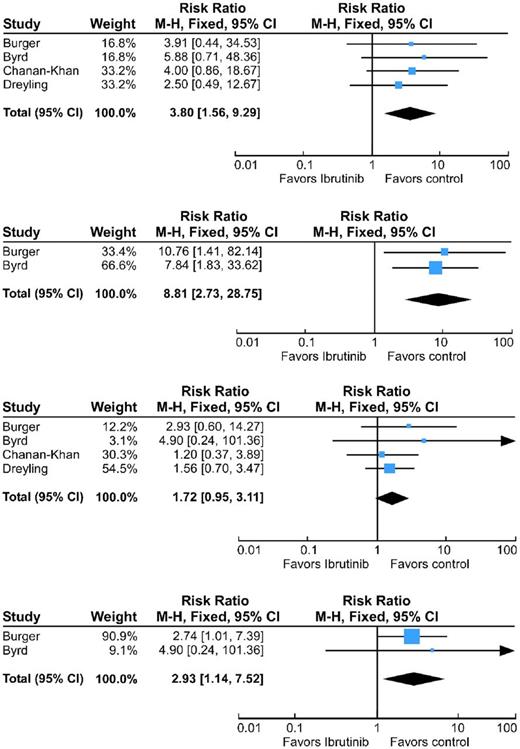Abstract
Background: Clinical trials raised a concern that ibrutinib may increase the risk of atrial fibrillation/atrial flutter (Afib/Aflutter) and major bleeding compared to chemoimmunotherapy (CIT). However, the association has not been statistically validated and there is no consensus regarding optimal management of anticoagulation among patients on ibrutinib who develop Afib/Aflutter. We performed a pooled-analysis of four randomized controlled trials (RCT) to precisely assess the risk of Afib/Aflutter and bleeding associated with ibrutinib treatment in patients with hematologic malignancies.
Materials and Methods: We searched PubMed, EMBASE, Cochrane Database, and meeting abstracts up to May 15, 2016 for RCTs comparing ibrutinib and CIT. Primary outcomes were serious Afib/Aflutter and major bleeding. Secondary outcomes were all-grade Afib/Aflutter and bleeding. We calculated the Mantel-Haenszel risk ratio (RR) and estimated the effect of the treatments using fixed-effects model.
Results: A total of 1,509 patients with CLL/SLL (n=1,231) or MCL (n=278) were included. Of these, 758 patients were treated with ibrutinib (n=330) or ibrutinib+bendamustine+rituximab (n=289), and 751 patients received CIT with either ofatumumab (n=191), chlorambucil (n=132), bendamustine+rituximab (n=289), or temsirolimus (n=139). Median age ranged 64-72.5 years, and 31.7% of patients were female. Ibrutinib dose was 420mg/day in three studies1-3 and 560mg/day in one study4. Compared to CIT, ibrutinib treatment was associated with a significantly higher incidence of serious Afib/Aflutter (RR=3.80, 95%CI=1.56-9.29, p=0.003, I2=0%, p=0.93), all-grade Afib/Aflutter (RR=8.81, 95%CI=2.70-28.75, p=0.0003, I2=0%, p=0.73), and all-grade bleeding (RR=2.93, 95%CI=1.14-7.52, p=0.03, I2=0%, p=0.72) (figure). There was no difference in major bleeding rates (RR=1.72, 95%CI=0.95-3.11, p=0.07, I2=0%, p=0.73) (figure). There were no significant subgroup RR differences between patients with CLL/SLL vs. MCL (RR=4.45 vs. 2.50, p=0.56, RR=1.91 vs. 1.56, p=0.73), treatment-naïve vs. refractory/relapsed disease (RR=3.91 vs. 3.78, p=0.98, RR=2.93 vs. 1.55, p=0.46), 560mg/day vs. 420mg/day dose (RR=4.45 vs. 2.50, p=0.56, RR=1.91 vs. 1.56, p=0.73), or <12months vs. ≥12months duration of ibrutinib exposure (RR=5.88 vs. 2.97, p=0.59; RR=4.90 vs. 1.81, p=0.53) for the serious Afib/Aflutter and major bleeding risk, respectively.
Conclusion: The risks of Afib/Aflutter and all-grade bleeding were significantly higher in the ibrutinib group. These results indicate the need for clinical vigilance in ibrutinib-treated patients with prior or treatment-emergent Afib/Aflutter requiring anticoagulation until further evidence on anticoagulation protocols emerges and the understanding of this adverse event and its management grow.
REFERENCES
1. Byrd JC, Brown JR, O'Brien S, et al. Ibrutinib versus ofatumumab in previously treated chronic lymphoid leukemia. N Engl J Med. 2014;371(3):213-223.
2. Burger JA, Tedeschi A, Barr PM, et al. Ibrutinib as Initial Therapy for Patients with Chronic Lymphocytic Leukemia. N Engl J Med. 2015;373(25):2425-2437.
3. Chanan-Khan AAA, Cramer P, Demirkan F, et al. Ibrutinib combined with bendamustine and rituximab (BR) in previously treated chronic lymphocytic leukemia/small lymphocytic lymphoma (CLL/SLL): First results from a randomized, double-blind, placebo-controlled, phase III study. J Clin Oncol. 2015;33.
4. Dreyling M, Jurczak W, Jerkeman M, et al. Ibrutinib versus temsirolimus in patients with relapsed or refractory mantle-cell lymphoma: an international, randomised, open-label, phase 3 study. Lancet. 2016;387(10020):770-778.
Analysis of risk ratio of Afib/Aflutter and bleeding.
Forest plots of risk ratios for serious Afib/Aflutter (A), all-grade Afib/Aflutter (B), major bleeding (C), and all-grade bleeding (D) from all available data. The size of the data markers (square) corresponds to the weight of the study in the pooled-analysis. The effects of interventions are calculated with the fixed effects model.
Analysis of risk ratio of Afib/Aflutter and bleeding.
Forest plots of risk ratios for serious Afib/Aflutter (A), all-grade Afib/Aflutter (B), major bleeding (C), and all-grade bleeding (D) from all available data. The size of the data markers (square) corresponds to the weight of the study in the pooled-analysis. The effects of interventions are calculated with the fixed effects model.
Abraham:Matrix45: Equity Ownership; Belgamis: Equity Ownership; Ex Ante International: Equity Ownership.
Author notes
Asterisk with author names denotes non-ASH members.


This feature is available to Subscribers Only
Sign In or Create an Account Close Modal